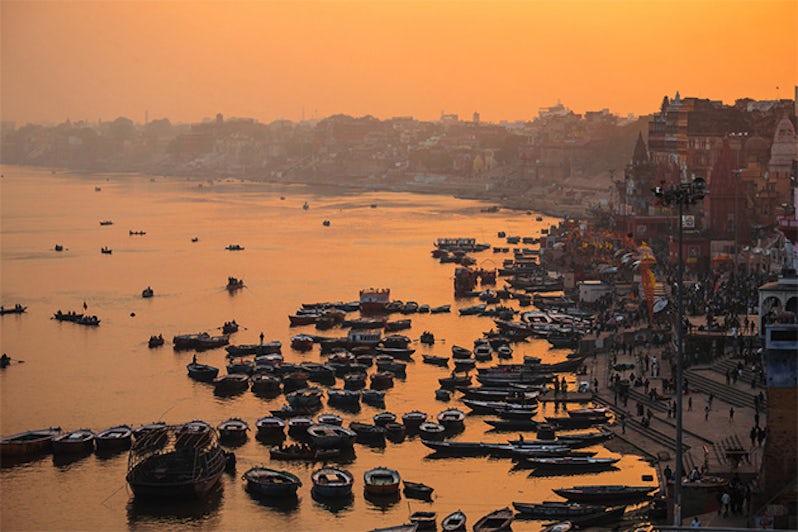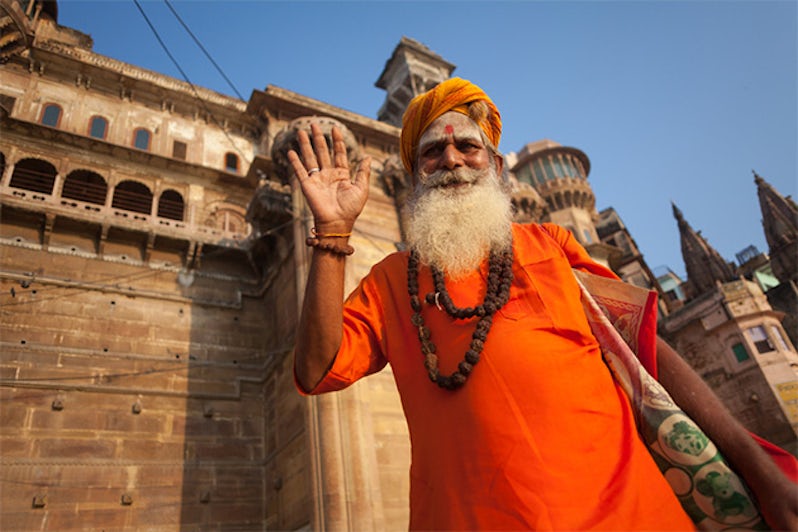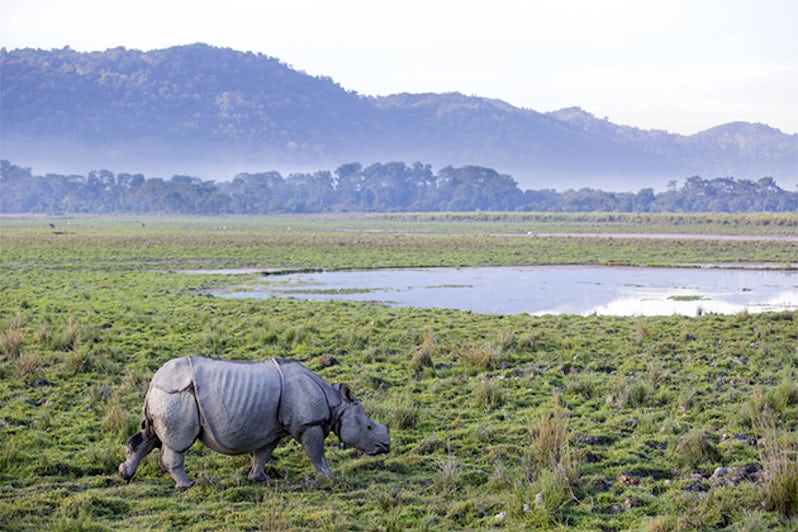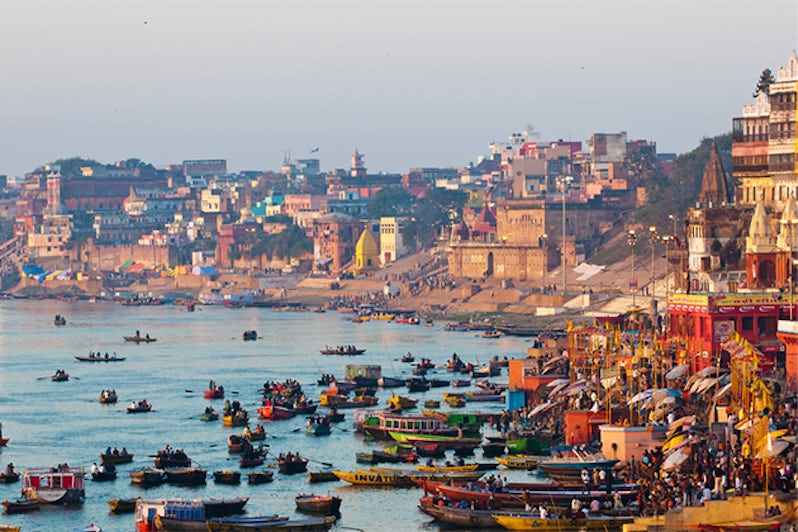Ganges River vs. Brahmaputra River Cruises


Mystical, magical India -- once the haunt of hippies, backpackers and spiritual seekers -- is going mainstream, as more and more Westerners set off to discover its glories on a river cruise.
The advantages of river cruising have been well documented; many have praised its ease and convenience. Once onboard, you can relax, take your 'hotel' with you and explore many places effortlessly, in a brief space of time without feeling rushed.
In India, those assets are even more important as, in the land of heat, dust and boundless bureaucracy, getting about by other means can be a hot and exhausting hassle.
Traveling aboard a 'floating hotel' is also the best bet for maintaining access to consistently high standards of food and sanitation, thus avoiding the dreaded 'Delhi Belly.'
But which India river cruise is best for you? At present, the main options for Western tourists are cruises along the famous Ganges river (and its tributary, the Hooghly, which flows through West Bengal), or the Brahmaputra, which wends its way through Assam in the country's northeast, within sight of the Himalayas.
Check out our whistle-stop guide to the main attractions of each river -- and then, to adapt an old saying -- you can pay your rupees and make your choice.

Ganges/Hooghly
Significance
Mata Ganga ('Mother Ganges') is one of the world's most famous rivers and lies at the very heart of Indian religious and cultural life -- so much so that Hindus consider its water sacred and traditionally keep a pot of it within their homes.
Where Is It
Flowing down from the Western Himalayas through northern India and Bangladesh, the Ganges spans nearly 1,600 miles before flowing into the Bay of Bengal.
Why Go
Along the Ganges banks you'll find much evidence of India's rich and varied history, in the shape of old French and British colonial settlements, elaborate palaces, temples and mosques, ancient cities, traditional villages and bustling ghats (riverside steps and jetties used for swimming, washing, religious ceremonies and cremations).
This mighty, much loved (but sadly, also much polluted) river will show you India in the raw, and offer memorable insights into the lifestyle, beliefs and customs of its people.
Best Time to Go
Temperatures are at their most moderate and the weather most temperate between October and April, outside the monsoon season. Unfortunately, this is also when water levels can be too low for riverboat access to Varanasi and the northern reaches of the Ganges, which are best visited at the tail end of the monsoon season, in late August and September. The downside of going then is that it could still be rainy; the upside is that, after their annual dousing, the Ganges' banks will be at their most verdant and beautiful.
Highlights
Ganges cruises combine well with tours of India's 'Golden Triangle' destinations: New Delhi, Agra (home to the Taj Mahal) and Jaipur, an UNESCO World Heritage Site. After visiting these, you'd fly to Kolkata to join your riverboat.
Most cruises begin with a day or two in Kolkata to take in local highlights like Mother Theresa's Mission House and the spectacular flower market. Then, as your boat sets sail, you can look forward to a river bird's view of Kolkata's colorful ghats as you float beyond the city limits to discover vast farmlands still tended by oxen (a ride on an ox cart being a must-try experience ashore).
Kalna: India's "Temple City" and home of the Nava Kailash, a spectacular circular temple complex constructed in 1809. It consists of more than 100 Shiv Mandirs (shrines containing statues of deities), and these are arranged in circles so that all can be seen from the center of the temple.
Matiari: A village community of artisans renowned for their finely wrought brassware.
Murshidabad: A traditional Bengali township and site of the vast Hazarduari Palace, famous for its thousand doors (around 900 of them false, to confuse invaders). The palace also holds valuable antiques and artworks from the days of British rule. The Katra Mosque, one of the most impressive in West Bengal, can also be visited here.
Baranagar: Usually reached by sampan (local flat-bottomed boat), this stop is notable for its beautiful 18th-century temples embellished with Bengalese terracotta artworks.
Mayapur: The birthplace of the founder of the Hare Krishna movement; a gigantic waterfront temple complex is his legacy.
Bandel: Another place usually reached by sampan, Bandel holds the Hooghly Imambara, one of West Bengal's most famous pilgrimage sites. Active both as a mosque and a ceremonial site, the Imambara has a large and impressive courtyard, and twin towers offering remarkable views over the surrounding countryside.
Chandannagar: A tiny piece of France in India, this charming town was colonized by the French for nearly 300 years, and their legacy is to be found in the gorgeous old colonial buildings that line its waterfront promenade.
Varanasi (Benares): Widely regarded as the spiritual capital of India, Varanasi lies in the north Indian state of Uttar Pradesh and dates from the 11th century. Hindus from all over the country gather here to bathe in the sacred Ganges and perform funeral rites, and the Aarti religious ceremony -- which takes place at 6:45 every evening at the city's Dashashwamedh Ghat -- is a sight to behold, with clanging bells, priests chanting mantras, the air wreathed in incense and candles set floating on the water.
Indeed, Varanasi is so special that many operators offer two or three day add-on stays there to river cruise itineraries, giving travellers time to see at least some of the city's 200 temples, which include the Kashi Vishwanath (or "Golden Temple"), dedicated to Shiva.

Brahmaputra River
Significance
The only "male" river in India, the Brahmaputra is a potent counterpart to the Great Mother Ganges, with which is conjoins toward the end of its 1,800-mile journey, just before both rivers spill out into the Bay of Bengal.
Where It Is
This winding river, whose massive 1,800-mile span takes it from the upper reaches of the Himalayas through Tibet and Bangladesh as well as northeast India, flows through the ‘tea country' of Assam, a land rich in history, natural beauty and exotic wildlife.
Why Go
The Brahmaputra is near Kaziranga, one of the world's great national parks, where you can join an elephant-back safari to spot jewel-colored birds, herds of wild deer, white rhino grazing placidly with their young and even -- if you're sharp-eyed and very lucky -- the occasional tiger.
You'll also find plenty of history and local color, in the shape of ancient temples, verdant tea plantations and stilted villages whose inhabitants make a living, as they have for centuries, by spinning raw silk into gorgeous bolts of embroidered cloth.
Best Time to Go
Cruises run from November to April, when the monsoon rains are over and the floods have receded, leaving the landscape lush and the temperatures -- and humidity -- moderate. Beware of traveling around Christmastime though, as heavy mists and fog can affect sailing schedules.
Highlights
Like the Ganges, the Brahmaputra can be combined with a Golden Triangle tour, followed by a flight to Kolkata. From there, you would take a short hop flight to either Jorhat or Guwahati, depending on whether your cruise is operating up or downstream.
Kaziranga National Park safaris: Apart from the Zambezi, the Brahmaputra is the only river to offer access -- by jeep, boat or on elephant-back -- to such an extensive variety of wildlife, including 480 species of birds and some spectacular animals, from white rhino and Indian elephants to huge-horned water buffalo, river otters, pink-tinted South Asian river dolphins and (if you're very lucky) even leopards and Royal Bengal tigers
Fabulous Mountain Views: On a clear day, you can watch the snow-capped peaks of the Himalayas as you drift by -- and their relative proximity keeps temperatures tolerable, even on hot days.
Living History: The banks of the Brahmaputra are lined with historic palaces, bustling temples and monasteries called Satras -- and many of the latter are still occupied by monks who invite you to witness centuries-old religious practices like the Matia Khora -- a traditional dance with drums and cymbals. Local villagers also maintain a lifestyle that has not changed for centuries, living in flood-resistant stilted houses and weaving fine silks from handmade wooden looms.
Glorious Scenery: Vast, unspoiled, silvery-white sand dunes flank the Brahmaputra, whose fast-flowing waters carve out a continuously changing landscape that provides a beautiful backdrop for evening barbecues and parties ashore. And beyond the sand dunes lie vast and verdant plantations, where you can learn all about the tea that made Assam famous throughout the world.

Bottom Line
If you want to immerse yourself in local life and really get under the skin of India, a cruise along the Ganges river is the choice for you.
If you want to get away from the crowds, see some of India's most beautiful landscapes and encounter its remarkable range of wildlife, then the Brahmaputra is a better choice.